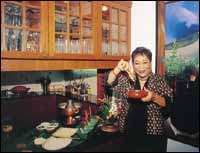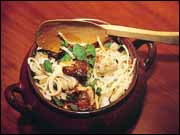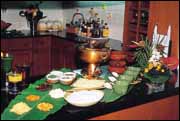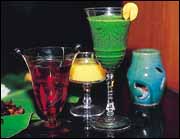


 Make Your Day With Kaukswe!
Make Your Day With Kaukswe!Passionate Foodie BAROTA MALHOUTRA makes the best Burmese Kaukswe this side of Rangoon. It's a popular one-dish meal that the Western world thinks is a delicacy, but which is really simple tribal food! |
|
ONE of the easiest one-dish meals to be made in the world, is Burmese Kaukswe. Anybody can make it. The Anglo-Saxon world thinks Kaukswe is a delicacy because of the ceremony in which it is prepared. And it thinks Kaukswe is Burmese food and Burmese food is Kaukswe! Which is a bit like the US and UK confusing all Indian food with curry. Just as "Dalda" has become the generic name for all hydrogenated oils, Kaukswe is the generic term for all Burmese food. The fact remains, however, that Kaukswe is basic tribal food! It spread from the tribals of Burma to Indian tribals in Assam, Meghalaya, Arunachal Pradesh, Mizoram, Manipur, Nagaland and Tripura. I am of Assamese origin, from a village called Mingale, and I learnt of Kaukswe from my Burmese nanny.
Of the 11 ingredients that go into Kaukswe, four you MUST absolutely have. These are garlic, ginger, onion and potato, all fried. The other ingredients are chopped green chillies, coriander, mint and spring onions, sambal powder, crushed red chillies, lemon juice, and chopped boiled eggs. Sambal powder is the secret ingredient that acts as a catalyst in the Kaukswe and takes it to new definitions. It is made of crushed dried fish, dessicated coconut and red chillies. I'm afraid, sambal powder is not available off the shelf and if you want to make authentic Kaukswe, you will have to make the sambal powder at home. It should not be too difficult. But people I know, have substituted sambal powder with all kinds of things. Like garam masala and sambhar powder. It works, but it doesn't quite do the trick! You start off making Kaukswe by cooking about 1 kg of meat (beef, lamb or chicken, the choice is yours) chopped into little cubes in the milk of one-and-half coconuts. This should be the thick, first stirring of coconut milk not the second lighter one. You cook this over a low fire for at least two hours so that the meat lends its essence to the milk to make a thick gravy. Once this is done, you eat the soup with the sticky rice or rice noodles that you have already boiled and into which you add the 11 ingredients.
Kaukswe is meant to be eaten spicy hot, because tribals like hot food. And this heat is provided by the green chillies and the sambal powder. I am asked if the basic ingredients can be changed while making Kaukswe and any other ingredients adapted. You can eliminate six out of 12 of the ingredients. But don't eliminate the chilli and sour content and the four basics, the fried garlic, ginger, onion and potato. In Kaukswe, the fringes become content and the embroidery becomes the substance! There are some that make a vegetarian Kaukswe with carrots and raddish, but I would not advise this. Hard cellulose vegetables like carrot and raddish take a long time to cook. Even green peas take a long time to cook. The essence of Burmese food is minimalism and simplicity. In Japanese food, it is minimalism and aesthetics.
|

Home Page
 So what is Kaukswe? It is essentially a soup, a well-brewed soup made of beef, but which can also be made with lamb and even chicken. It is all a matter of taste. This soup is mixed with sticky rice or rice noodles. And into, or with, this soup is served 12 other ingredients that have been chopped and kept in readiness in small little bowls. People's imaginations have led them to describe Kaukswe as a chopsuey and alternatively, as a bhelpuri! But once you taste it, you'll know it is like nothing else on earth. Kaukswe�s eaten all over Burma as a meal. But not everyday because meat, which is a substitute for game, is expensive, and not freely available. The tribals treat Kaukswe like a special dish. Like a khichdi!
So what is Kaukswe? It is essentially a soup, a well-brewed soup made of beef, but which can also be made with lamb and even chicken. It is all a matter of taste. This soup is mixed with sticky rice or rice noodles. And into, or with, this soup is served 12 other ingredients that have been chopped and kept in readiness in small little bowls. People's imaginations have led them to describe Kaukswe as a chopsuey and alternatively, as a bhelpuri! But once you taste it, you'll know it is like nothing else on earth. Kaukswe�s eaten all over Burma as a meal. But not everyday because meat, which is a substitute for game, is expensive, and not freely available. The tribals treat Kaukswe like a special dish. Like a khichdi!
 Sticky rice is poor people's cereal, it is a tribal rice, and you have to use something similar to this for Kaukswe. Not Basmati! Fortunately, there is available in grain shops a parboiled, red tribal rice from Kerala. It is unhusked and goes well with Kaukswe. Or you get rice noodles. In a soup bowl, put some rice or noodles, put in as much stock of soup as you want and then with your fingers, drop in a pinch of each of the 11 ingredients. Just blob it. Last of all, add the lemon juice. The final word is the khatta, the lemon juice. Don't mix the Kaukswe but eat it as it is, with chopsticks or a spoon.
Sticky rice is poor people's cereal, it is a tribal rice, and you have to use something similar to this for Kaukswe. Not Basmati! Fortunately, there is available in grain shops a parboiled, red tribal rice from Kerala. It is unhusked and goes well with Kaukswe. Or you get rice noodles. In a soup bowl, put some rice or noodles, put in as much stock of soup as you want and then with your fingers, drop in a pinch of each of the 11 ingredients. Just blob it. Last of all, add the lemon juice. The final word is the khatta, the lemon juice. Don't mix the Kaukswe but eat it as it is, with chopsticks or a spoon.
 Finally, when do you make Kaukswe at home? My answer is any time. Get familiar with it, then introduce your friends and guests at a party to it. But I am afraid, I have learnt that you cannot only offer Kaukswe at a party. Indians just don't understand the one-dish meal concept. The householder, when she calls people over, must have a plethora of foods. Indians don't believe that less is more. And don't, don't make your soup stock for Kaukswe in the microwave. You have to do this on a slow fire preferably on a heavy-bottomed dekchi. Or use a crock pot. Having Kaukswe is a bit like eating fondue. You sit around a table with the stock pot, the rice and noodles and little bowls of 11 ingredients, and help yourself. It's about getting together with friends. The tribals do this over a tumbler of Chang, which is rice wine, but I serve Kaukswe with juices made or berry, coriander, celery and mint!
Finally, when do you make Kaukswe at home? My answer is any time. Get familiar with it, then introduce your friends and guests at a party to it. But I am afraid, I have learnt that you cannot only offer Kaukswe at a party. Indians just don't understand the one-dish meal concept. The householder, when she calls people over, must have a plethora of foods. Indians don't believe that less is more. And don't, don't make your soup stock for Kaukswe in the microwave. You have to do this on a slow fire preferably on a heavy-bottomed dekchi. Or use a crock pot. Having Kaukswe is a bit like eating fondue. You sit around a table with the stock pot, the rice and noodles and little bowls of 11 ingredients, and help yourself. It's about getting together with friends. The tribals do this over a tumbler of Chang, which is rice wine, but I serve Kaukswe with juices made or berry, coriander, celery and mint!